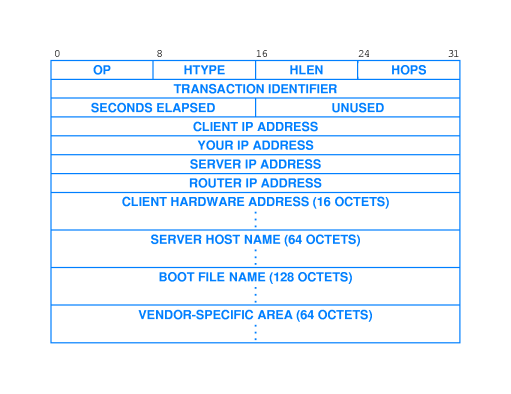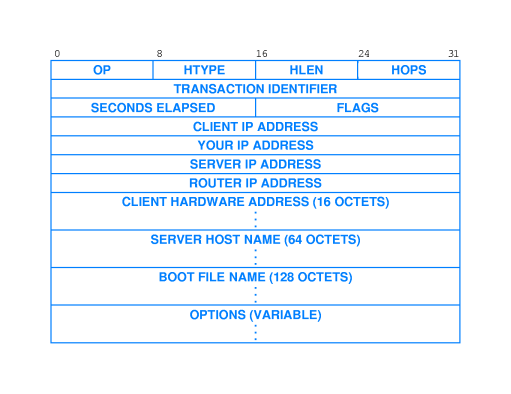(Latest Revision:
Fri May 18 04:13 PDT 2007
)
Notes On Chapter Forty-One
-- Initialization (Configuration)
41.1 Introduction
- This chapter is about how protocol software
gets started as a host or router boots up.
41.2 Bootstrapping Protocol Software
- Typically a computer executes a ROM boot
sequence when you turn it on.
- The ROM program loads a bootstrap program
from a known location on disk.
- The computer executes the bootstrap program.
- The bootstrap program loads the operating
system and the computer then starts executing the operating
system.
41.3 Protocol Parameters
- Protocol software is generic. Something has to pass it specific
parameters when it starts up. Parameters are things like the host
MAC and IP addresses, and the network mask.
41.4 Protocol Configurations
- Protocol configuration is the giving of
values to the parameters of the protocols.
- There are different ways to do it.
- In order to boot successfully sometimes a system has to use the
network before the protocol software is fully configured. The system uses partially configured software to
obtain information it needs to complete the configuration.
(It has to lift itself with its own bootstraps -- this illustrates
how the term "boot" originated.)
41.5 Examples of Items That Need To Be Configured
What is needed varies with the protocol.
Typically TCP/IP needs:
- Host IP address(es)
- Default router IP address
- Subnet mask(s)
- DNS server IP address(es)
41.6 Configuration From Stable Storage
- If a system boots off a hard disk then usually
much of the protocol configuration information will be stored in one
or more files on disk
- The booting system will read the information, transform into the
appropriate internal form, and store.
- If this information is changed, it may be possible to signal the OS
to reread it. Sometimes a reboot is required - or at least is the
preferred method.
- (Examples of configurations files in folder /private/etc on
Macs: hostconfig, resolv.conf, hosts, hosts.equiv, hosts.lpd,
inetd.conf, networks, protocols, services, and probably others;
in directory /etc on Suns: defaultdomain, defaultrouter,
hostname.hme0, hosts, hosts.allow, host.deny, hosts.equiv,
inted.conf, netconfig, nodename, resolv.conf, and probably
others.)
- The reader should bear in mind that when a network information
database such as netinfo, NIS+, or LDAP is in use the information
in the files may be used only as a backup to information that
hosts obtain through queries to the distributed database.
41.7 The Need To Automate Protocol Configuration
- When there are large numbers of computers to administrate it can become a challenge to keep all the
configuration files updated with the right information.
- Portable computers are a special challenge
in this regard because users move them from one network to
another.
41.8 Methods For Automated Protocol Configuration
- A booting host can "ask the network" for a
bootstrap program.
- A host that does not know its own IP address
can use Reverse Address Resolution Protocol (RARP) to get the
information from a server. (It broadcasts its MAC address
and receives a reply from a server.)
- A host can broadcast ICMP messages and get back
its address mask and the IP address of a router.
- It may take a lot less work to set up the servers that furnish the
BOOTP, RARP, and ICMP information if the only alternative is to put
copies of the information in files on each host.
41.9 The Address Used To Find An Address
- The configuring of the protocol software can be done in layers from
lowest to highest. Higher layers can use the
functionality of lower layers to obtain (some of ) their
configuration information.
41.10 A Sequence Of Protocols Used During Bootstrap
- Broadcast a RARP Request message to
obtain an IP address
- Wait for a RARP Response message. If
none arrives within T1 seconds, return to step 1.
- Broadcast an ICMP Address Mask Request
message.
- Wait for an ICMP Address Mask Response
message. If none arrives within T2 seconds, return to
step 3.
- Use ICMP Gateway Discovery to find the
IP address of a default router, and add a default route to the
routing table.
41.11 Bootstrap Protocol (BOOTP)
- BOOTP is a newer protocol which a host can use
to get all the RARP and ICMP information mentioned above -- and more
-- with just one request.
- The requesting host uses the broadcast destination address in the
request packet and uses all zero's (meaning "me") for the source
address.
- A server answers. It may broadcast the answer
or use the hardware address that arrived in the request packet to
designate the recipient.
- The format of the BOOTP packet and an explanation of most fields
appears on pages 629-630 of the fourth edition (figure reproduced
below).

41.12 Dynamic Host Configuration Protocol (DHCP)
- A computer C can't use BOOTP unless someone has
entered information about C into a server database in advance.
- DHCP can allow a "complete stranger" to join a
network.
- The booting client broadcasts a DHCP request and a DHCP server
responds.
- The DHCP server has a pool of IP addresses.
DHCP can give an address from the pool to a "stranger."
- DHCP can also accommodate a "server computer"
that needs to have a fixed IP address. The "server
computer" must be registered with the DHCP server. The DHCP server
will recognize the "server computer" by its hardware address, and
give it the particular IP address associated with that hardware
address.
- The DHCP server can refuse to extend the lease on an IP address
it has assigned.
41.13 Optimizations in DHCP
- After a power excursion a large number of computers may boot at
about the same time. This could overwhelm the DHCP server.
- Clients wait a random time before making their
DHCP request. This helps alleviate possible swamping of
DHCP servers.
- The client actually sends a "discover"
broadcast to find a DHCP server. The client picks one of
the DHCP server(s) that replies to the client. The client then
sends its request for protocol configuration information to that
server.
- A client may cache the identity of the DHCP server that responded to
it. Also the client may cache the IP address it received from the
server. When rebooting, the client may simply try to revalidate its
former IP address with its former server.
41.14 Indirect Server Access Through A Relay
- DHCP can work for a client X even if there is
no DHCP server on X's network
- If a relay agent is present on
X's network, configured with the IP address of a DHCP server, it
will forward the request to the server
using unicast and relay the reply to the client.
- It is relatively simple to manage one or a few centralized DHCP
servers and a multiplicity of relay agents.
- Many commercial routers are easy to configure as relay agents.
41.15 DHCP Message Format
- The DHCP message and protocol is not much different than BOOTP.
- See page 633 of the fourth edition for details (figure reproduced
below).

41.16 DHCP And Domain Names
- If a computer is not registered with the DHCP
server then it may get different IP addresses when it boots
at different times. It will be "hard" for such
a computer to keep the same domain name across reboots.
- To ameliorate that situation, there is a protocol which would allow
DHCP to "talk to" DNS to notify DNS of the change in mapping between
IP address and domain name. However, that protocol has not been
widely deployed.
- If we want a set of computers to have fixed IP addresses and domain
names under DHCP, then it helps to have them all registered with
DHCP.
- However if the computers are registered by hardware address, we have
to change the DHCP database each time we introduce a new hardware
address. This happens when we change the NIC of an existing
computer, or when we add a new computer to the network.
41.17 Summary

